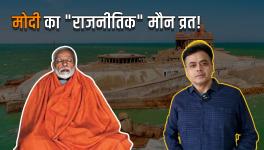How Secret Are Votes Cast in EVMs?
Image for representational use only.Image Courtesy : Livemint
While the 2019 general elections are around half-way through, the next point of anticipation will be the counting of votes. However, the manner in which the votes should be counted has been a matter of a public interest litigation (PIL) filed in 2014.
Unlike with paper ballots, the present law does not provide for votes to be mixed before counting. The petitioners in the PIL -- which is pending -- have urged that a totaliser machine ought to be used for counting votes to obscure the voting patterns.
The government, on the other side, in January last year, submitted that a Group of Ministers had considered this aspect in September 2016 after consulting all other national political leaders and the Election Commission (EC). The decision arrived at was not to go for the introduction of totaliser machines in the present existing system.
What is a Totaliser?
Bharat Electronics Limited and the Electronics Corporation of India Limited developed the totaliser as a machine to count votes without disclosing how many votes each candidate has received on each individual Electronic Voting Machine (EVM). The concept is simple, as up to 14 EVMs can be attached to a totaliser, and the machine will only display the collective tally for each candidate rather than for each individual machine. Both the ECI as well as the Law Commission of India have recommended its use as a method to protect the secrecy of votes.
The primary reason for keeping votes secret arises out of the possibility that ‘punishment’ will be meted out to those who did not vote in favour of the winning candidate. With the current system of counting, the candidates or their representatives are present throughout the counting process. Hence, it is easier to guess the number of votes recorded in each booth.
Also Read | SC Asks EC to Increase VVPAT Verification to 5 per Constituency
Conduct of Elections Rules
Rule 59A in its present form provides the ECI with the power to issue a notification specifying the constituencies where the ballots were to be mixed before counting. The provision was first introduced in 1968 and later amended in 1993.
In January 2018, regarding the PIL, Attorney General KK Venugopal told the Supreme Court that the practice prior to the introduction of Rule 59A was that ballot papers were mixed before counting. However, prior to 1968, there were individual ballot boxes for each candidate. This was later changed to a single ballot box and the names and party symbols of each candidate printed on a common ballot paper. Thus, Rule 59A provides for secrecy of votes cast by ballots. However, with the issues surrounding paper ballots, such as ballot stuffing, the move towards EVMs ensured that such practices were more difficult to replicate.
Following the introduction of EVMs, Rule 66A was inserted to provide for counting votes cast digitally. However, the Rules inserted after EVMs were introduced, did not provide for ‘mixing’. However, considering how electioneering has become so data driven, the absence of any such provision appears to highlight a lack of foresight. Rule 66A only provides for the basic procedure to be followed, such as all the candidates or their representatives checking whether the seals on the EVM have been tampered with and that their presence is required.
Also Read | Elections 2019: 66 Civil Servants Write to President, ‘Credibility of EC at All-time Low’
The government’s opposition to the use of totaliser machines is premised on the argument that the data is important to tailor policies to specific wards and constituencies. Considering that after the PIL was instituted, the right to privacy has been affirmed by the Supreme Court as a facet of the right to life and personal liberty, the argument for totaliser machines takes a different turn. It then becomes a question of protecting the right to privacy of voters. However, since a voter’s name does not appear against his/her vote, the issue of privacy raises the question whether there can be a collective right to privacy rather than only an individual right.
Get the latest reports & analysis with people's perspective on Protests, movements & deep analytical videos, discussions of the current affairs in your Telegram app. Subscribe to NewsClick's Telegram channel & get Real-Time updates on stories, as they get published on our website.
























